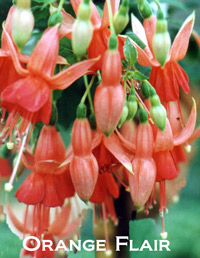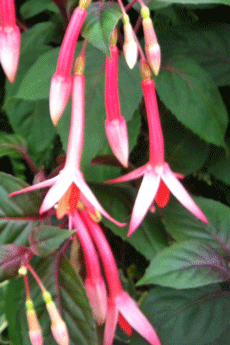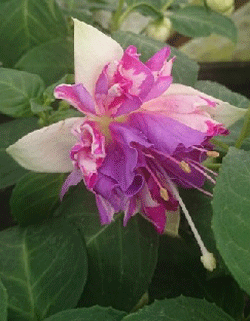|
|
O |
|
|
|
|
|
Orange Crush. 1972 (Hadley). Single. Medium sized flowers with pale orange salmon tube and sepals with green tips, bright orange shortish corolla and small light green leaves. |
|
|
|
|
Orange Drops. 1963 (Martin). Single. Sepals orange with darker orange corolla. Good dark foliage heavily serrated. Arching habit. |
|
|
|
|
Orange Flair. 1972 (Hadley). Single. Largish flowers with thick tube and wide sepals of orange salmon and with orange corolla and filaments. |
|
|
|
|
Orange King. 1975 (L.A. Wright) Double. Tube and Sepals pale salmon-pink, darker underside of sepals. Corolla opens rich orange, marbled pale orange. Exotic brightly coloured blooms, freely produced for size. Growth lax bush. Suitable for container or hanging basket. Thoroughly recommended and much admired.
|
|
|
|
|
Orient Express. 1985 (Goulding) Triphylla. Long single flowers in terminal clusters. Sepals pink, paler underside. Coralla pink. Upright bush makes a good conservatory plant. |
|
|
|
|
Ornamental Pearl. 1984 (Gubler). Single. Tube and Sepals pale pink, sepals long and edged deeper pink. Corolla white. Flowers medium and free. Most unusual variegated grey-green foliage edged cream, with burgundy hue over new growth. Upright self-branching bush. |
|
|
|
|
Over The Waves New 2018 (Gerald Blackwell) Double. Tube and Sepals ice white. Corolla blue marbled pink. Lax bush Highly recommended extremely vigorous. Very versatile can be trained into any shape. |
|
|
|
PLEASE NOTE FOR WINTER MONTHS: H.1. requires greenhouse heated to minimum of 40°F (4.5°C). Although the above classifications are our recommendations, many of our customers are growing fuchsias that we classify as H.2 out of doors with good results and obviously with bigger blooms produced on H.2's than on The RHS and the British Fuchsia Society list many fuchsias that we classify as H2 medium hardy, as H3 hardy and with the climate changes (Global warming) this has probably become a fact |
|
|
|
A B C D E F G H I J K L M N O |
|||







